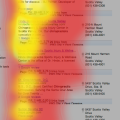How and why to keep away the dreaded Google bounce
75% bounce. 63% bounce. 95% bounce. 38% bounce. Maybe you’ve seen those in your Google Analytics, and if you don’t know what I’m talking about, then you’re missing an important metric in that last column (see screenshot below) that Google graciously gives you to help you win the internet marketing game.

Bouncing ball is not the game you want to play
Bouncy rubber balls might be fun for kids, but bouncing is no fun for online businesses. In fact, it can be downright painful because if they bounce too high, Google will return with a slap so hard it can bury that web page of yours into the ground – and then the game is over.
So what is a bounce?
Google defines bounce rate this way:
“Bounce rate is the percentage of single-page visits or visits in which the person left your site from the entrance (landing) page.”
In other words, bounce is the opposite of stick, so getting people to stick on your site is the goal.
And why should the bounce rate matter to you?
1. Google uses the bounce rate as a signal for the relevancy and popularity of your web page.
Imagine yourself sitting outside a coffee shop on a park bench reading a paper and you notice that everyone who walks into the shop immediately turns away. Other than raise your curiosity about why, after enough people walk away without stepping further than the threshold or coming back out in a matter of seconds, would you think the coffee shop really met those visitors needs? And worse, wouldn’t you think there was something in that shop that was repelling them?
This is what Google thinks when people bounce off your site. Remember, it wants to return results people will be happy with, results they care about and provide what they are looking for.
Google knows which keywords brought them to the site. If people using a particularly keyword consistently turn away, what will Google think about that keyword and its relevancy to you? Clearly, it would think it’s irrelevant.
Why else should you care?
Because if people are bouncing away, they don’t like what you’re offering them.
What should you do about keywords that you want to be relevant to you but that continually bounce people away?
1. Give them what they want.
Make sure the pages that are pulling people in on your keywords actually give them what they want and make them want to stay. How do you do that?
- First step is to make sure your Title and description metatags are actually relevant. Those are the tags that show up in a Google query. They may be misleading and bringing people in under “false pretenses.”
- Second, if those metatags are right for you, check to be sure the copy on your page continues on after that “metatag introduction,” and that it fills the need of the searcher.
In the example above, you can see lots of bounces for the keywords “Santa Cruz chiropractors” but not for “Santa Cruz chiropractor.” Why?We can’t know for sure, but possibly because those looking want to see a complete list of chiropractors in Santa Cruz. Or maybe they’re comparison shopping from one to another.
I don’t know for sure. But in any case, I’d want to try and keep them there and turn them into a customer. I’m making that attempt by drawing lots of attention to Dr. Griffin’s great reviews and “Best Chiropractor” award. No need to comparison shop if you have the best right here is my logic.(On the other hand, maybe they are not really bounces at all! See the “Google, listen up” subheading below.)
- Third, make it really clear, visually clear, that that page is about those metatags.– Use descriptive subheadings that are big, bold and complete, or almost complete, sentences.
– Use bullet points to make it easy to see the points you are making on that page.
I tell my clients to squint when reviewing your page. What stands out? If the keywords, your message, and your call to action don’t, then you have a problem.
Check out the screenshots below and see what a difference the subheadings and heading within the body of the copy make on that page.
Not so sticky

In the screenshot above, you’ll see that Dr. Griffin has links to blog topics on the right which can draw clicks and prevent bounces, and that’s good, but remember, most people landing here are looking for a Santa Cruz Chiropractor.
How well does that page convert for her?
Stickier with less bounce
Would this one get you to stick around more?

Note the title’s reference to “Best Chiropractor,” and the Yelp box on the right.
If you want a great chiropractor in Santa Cruz, would you think you found one or would you bounce away? Stick? or bounce?
2. Dangle the carrot.
Additionally, try to lead people further into your site so they don’t bounce. This is particularly challenging on blog posts because many people just come for the information in that particular post.
How do you get them to visit other pages?
- Invite them to read more by whetting their appetite about other topics you wrote about. You can do this by referencing other articles directly within the article.
- Include the “latest posts” links in your sidebar.
- Use WordPress’ “Related Posts” plugin to show them related posts at the end of the post. (And fix it if it’s breaking as it is in this blog!)
- Offer a special discount (and make it attractive and eye-catching), but make them click to another page to actually get it.
- Place a call to action and lead capture form on every page. Once the page is submitted, they are directed to another page, and, voilá, no bounce.
But, Google listen up, a bounce is NOT always a clear indicator that people aren’t finding what they came looking for.
Why do I say that? Because you may have done such a great job on your landing page that you sold them immediately, and because you put the phone number very visible on every page, maybe they picked up the phone to call you without clicking anywhere in your site.
So I was particularly pleased when I read this tweet by @ruthburr on Twitter in her Pubcon tweets:
“What constitutes a bounce? If a 1-page visit is much shorter than the norm across the ecosystem (depends on niche).”
Did this come from Google itself? I don’t know. I wasn’t there, but I’m trying to find out. Does anyone reading this know?
The bigger question is, is Google now considering time on the page when determining whether or not something is a bounce?
Think about this. Let’s say your niche is plumbers. Most looking for a plumber might check out a page, then call. If they call, they will be sitting on that page for awhile, perhaps not clicking into the site at all – why would they? They already decided to call that plumber. Maybe they even left the page open and walked away with their phone. This probably happens a lot.
So maybe, just maybe, Google is taking this into consideration. According to this logic, then, Google might not consider a one-page visit to the plumber’s site (niche) a bounce unless the visitor didn’t stay long enough to make a phone call. And that would also mean, if Google is doing that, that the bounces for “Santa Cruz chiropractors” shown above really are the kind of bounces that hurt, and by that I mean the kind that hurt business because those bouncers haven’t taken the time to call.
I’m hoping that there is truth in that Tweet. Until we know for sure, though, do your best to catch the ball before it bounces.
And now that you’ve read this, I bet you’re thinking you never knew so much went into SEO. At least that’s true with this SEO.
P.S. If anyone reading this has clever ways to move visitors through the site, please post in comments below.
- How to reclaim ownership of your Facebook business page - May 7, 2025
- How to get reviews using QR codes and boost your rank in Google - November 14, 2023
- How to Improve Behavioral Signals on Your GBP to Help Rank - May 14, 2023







